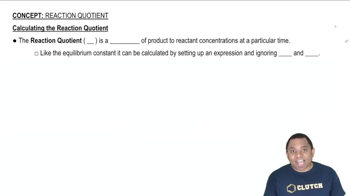Consider the following equilibrium: Ag+ (aq) + Cl-(aq) → AgCl(s) Use Le Châtelier's principle to predict how the amount of solid silver chloride will change when the equilibrium is disturbed by: (a) Adding NaCl (b) Adding AgNO3
Ch.15 - Chemical Equilibrium
Chapter 15, Problem 119
Will the concentration of NO2 increase, decrease, or remain the same when the equilibrium NO2Cl(g) + NO(g) ⇌ NOCl(g) + NO2(g) is disturbed by the following changes? (a) Adding NOCl (b) Adding NO (c) Removing NO (d) Adding NO2Cl; also account for the change using the reaction quotient Qc
 Verified step by step guidance
Verified step by step guidance1
Step 1: Understand the equilibrium reaction: NO2Cl(g) + NO(g) ⇌ NOCl(g) + NO2(g). This is a dynamic equilibrium where the rate of the forward reaction equals the rate of the reverse reaction.
Step 2: Apply Le Chatelier's Principle, which states that if a system at equilibrium is disturbed, the system will adjust itself to counteract the disturbance and restore a new equilibrium.
Step 3: For each change, determine the direction in which the equilibrium will shift: (a) Adding NOCl will increase the concentration of a product, causing the equilibrium to shift left to consume NOCl and produce more reactants. (b) Adding NO will increase the concentration of a reactant, causing the equilibrium to shift right to consume NO and produce more products. (c) Removing NO will decrease the concentration of a reactant, causing the equilibrium to shift left to produce more NO. (d) Adding NO2Cl will increase the concentration of a reactant, causing the equilibrium to shift right to consume NO2Cl and produce more products.
Step 4: Use the reaction quotient Qc to confirm the direction of the shift: Qc is calculated using the concentrations of the products over the reactants. Compare Qc to the equilibrium constant Kc. If Qc < Kc, the reaction will shift right; if Qc > Kc, the reaction will shift left.
Step 5: Analyze the effect on NO2 concentration: (a) Adding NOCl will decrease NO2 concentration. (b) Adding NO will increase NO2 concentration. (c) Removing NO will decrease NO2 concentration. (d) Adding NO2Cl will increase NO2 concentration.
Key Concepts
Here are the essential concepts you must grasp in order to answer the question correctly.
Le Chatelier's Principle
Le Chatelier's Principle states that if a dynamic equilibrium is disturbed by changing the conditions, the system will adjust to counteract the change and restore a new equilibrium. This principle helps predict how the concentrations of reactants and products will shift in response to changes such as concentration, pressure, or temperature.
Recommended video:
Guided course

Le Chatelier's Principle
Equilibrium Constant (Kc)
The equilibrium constant (Kc) is a numerical value that expresses the ratio of the concentrations of products to reactants at equilibrium for a given reaction at a specific temperature. It provides insight into the extent of the reaction and helps determine the direction in which the reaction will shift when the system is disturbed.
Recommended video:
Guided course

Equilibrium Constant Expressions
Reaction Quotient (Qc)
The reaction quotient (Qc) is a measure of the relative concentrations of products and reactants at any point in time, not just at equilibrium. By comparing Qc to Kc, one can predict the direction in which the reaction will shift to reach equilibrium: if Qc < Kc, the reaction will shift to the right, and if Qc > Kc, it will shift to the left.
Recommended video:
Guided course

Reaction Quotient Q
Related Practice
Textbook Question
Textbook Question
Consider the following equilibrium: Ag+ (aq) + Cl-(aq) → AgCl(s) Use Le Châtelier's principle to predict how the amount of solid silver chloride will change when the equilibrium is disturbed by: (c) Adding NO3, which reacts with Ag+ to form the complex ion Ag(NH3)2+
Textbook Question
Consider the following equilibrium: Ag+(aq) + Cl-(aq) ⇌ AgCl(s) Use Le Châtelier's principle to predict how the amount of solid silver chloride will change when the equilibrium is disturbed by: (d) Removing Cl-; also account for the change using the reaction quotient Qc
Textbook Question
For the water–gas shift reaction CO1g2 + H2O1g2 ∆ CO21g2 + H21g2, ΔH° = - 41.2 kJ does the amount of H2 in an equilibrium mixture increase or decrease when the temperature is increased? How does Kc change when the temperature is decreased? Justify your answers using Le Châtelier's principle.
Textbook Question
Consider the exothermic reactionCoCl 2-1aq2 + 6 H O1l2 ∆ Co1H O2 2 + 1aq2 + 4 Cl-1aq2 which interconverts the blue CoCl 2- ion and the pinkCo 2 +CoCl 2- increase or decrease when the following changes occur?(c) The solution is diluted with water.
